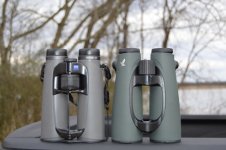My selected 12x45 Russian binocular easily and certainly and repeatedly outresolves the Nikon 10x35 EII terrestrially for me.
Hand held not braced.
The 12x45 is long old fashioned but beautifully well balanced.
The 12x45 has poorer transmission and a yellowish cast.
The Canon 10x30 IS II outresolves both when the stabilser button is pressed.
It is a personal thing and depends on which 12x binocular one chooses.
I have no problem hand holding and seeing more detail with 12x or 15x or 20x binoculars, depending on size, weight and inertia.
P.S.
The other main factors are the length of time of observations, general and critical detail observation.
Length of pauses in observation.
Tiredness.
Strength of the observer. A heavy binocular is steadier than a light one.
Whether one has something on which to rest ones arms or the binocular or both.
A lower magnification binocular is more restful long term but may not show as much detail as a high powered one.
Hand held not braced.
The 12x45 is long old fashioned but beautifully well balanced.
The 12x45 has poorer transmission and a yellowish cast.
The Canon 10x30 IS II outresolves both when the stabilser button is pressed.
It is a personal thing and depends on which 12x binocular one chooses.
I have no problem hand holding and seeing more detail with 12x or 15x or 20x binoculars, depending on size, weight and inertia.
P.S.
The other main factors are the length of time of observations, general and critical detail observation.
Length of pauses in observation.
Tiredness.
Strength of the observer. A heavy binocular is steadier than a light one.
Whether one has something on which to rest ones arms or the binocular or both.
A lower magnification binocular is more restful long term but may not show as much detail as a high powered one.
Last edited:






